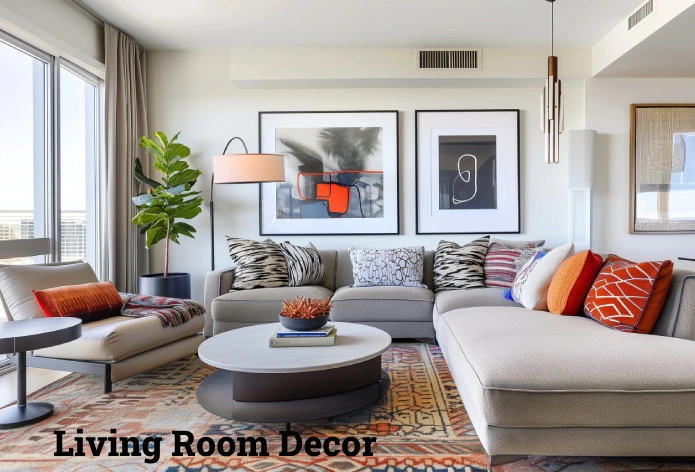Imagine stepping into a living room where every element seamlessly blends together, creating a harmonious and inviting atmosphere. From the color palette to the furniture, accessories, and lighting, each aspect complements the other, resulting in a visually stunning and cohesive space. Achieving this level of cohesion in your living room decor can transform your home into a sanctuary of comfort and style.
In this comprehensive guide, we will delve into the art of creating a cohesive look in living room decor, exploring the fundamental principles, practical tips, and creative strategies that will help you design a space that exudes unity, balance, and your unique personal style.
A. Definition of a Cohesive Look in Living Room Decor
A cohesive look in living room decor refers to the harmonious integration of various design elements, including color, furniture, textures, patterns, and lighting, to create a unified and visually pleasing environment. It’s about establishing a sense of flow and consistency throughout the space, where every component contributes to an overall aesthetic that feels intentional and well-thought-out.
Importance of Creating a Cohesive Look
A cohesive living room decor not only enhances the visual appeal of your space but also contributes to a sense of calmness and comfort. It creates a sense of flow and continuity that makes the room feel well-organized and intentionally designed. By establishing cohesion in your living room, you can create a space that reflects your personal style and serves as a welcoming retreat for you and your guests.
Overview of the Key Elements for Achieving a Cohesive Living Room Decor
To achieve a cohesive look in your living room decor, you’ll need to consider several key elements, including:
- Color scheme: Selecting a harmonious color palette that ties the space together.
- Furniture: Choosing furniture styles and materials that complement each other.
- Textures and patterns: Incorporating textures and patterns that enhance the visual interest while maintaining cohesion.
- Lighting: Utilizing proper lighting to create the desired ambiance and highlight the cohesive design.
- Space planning: Arranging furniture and creating functional zones that contribute to the overall cohesion.
- Personalization: Adding personal touches that reflect your style while maintaining the cohesive look.
By mastering these elements and applying them strategically, you can create a living room that exudes a sense of unity and harmony, making it a space you’ll love to spend time in.

Understanding the Fundamentals of Cohesive Living Room Decor
A. Color Scheme and Its Impact on Cohesion
Color plays a crucial role in creating a cohesive living room decor. A well-chosen color scheme can tie the entire space together, making it feel harmonious and visually appealing. Whether you opt for a monochromatic palette, complementary colors, or a triadic color scheme, selecting hues that work well together is essential. The right color scheme can also influence the mood and ambiance of the space, making it feel calming, energizing, or cozy.
The Role of Furniture in Creating a Cohesive Look
Furniture is the backbone of your living room decor, and choosing pieces that complement each other can significantly contribute to the overall cohesion. Consider selecting furniture styles that share similar design elements, such as clean lines, curved shapes, or ornate details. Additionally, aim for consistency in materials, whether it’s wood, upholstery, or metal, to create a sense of unity throughout the space.
Importance of Balance and Symmetry in Living Room Decor
Balance and symmetry play a crucial role in creating a cohesive living room decor. Aim for a balanced distribution of furniture, accessories, and visual elements, ensuring that no one area feels too heavy or empty. Symmetry can be achieved by arranging furniture and decor in a way that creates visual harmony, such as placing matching chairs or lamps on either side of a sofa or console table.
Choosing the Right Color Palette for Your Living Room
A. Exploring Different Color Schemes and Their Effects
When selecting a color palette for your living room, consider exploring different color schemes and their effects. Monochromatic schemes, using different shades of the same color, can create a sense of calm and unity. Complementary colors, which are opposite on the color wheel, can add visual interest and vibrancy. Analogous color schemes, which use hues that are adjacent on the color wheel, can create a harmonious and soothing atmosphere.
Tips for Selecting a Harmonious Color Palette
To select a harmonious color palette for your living room, start by choosing a dominant color that you love. Then, consider adding one or two complementary or analogous colors to create visual interest and depth. You can also incorporate neutral colors like white, gray, or beige to balance out bolder hues. When selecting colors, consider the lighting in your living room, as natural and artificial light can affect how colors appear.
Incorporating Accent Colors for Visual Interest
While a cohesive color palette is essential, incorporating accent colors can add visual interest and prevent the space from feeling monotonous. Use accent colors sparingly, such as in throw pillows, artwork, or decorative accessories, to create focal points and add pops of color. Accent colors should complement your main color scheme and be used judiciously to maintain cohesion.
Selecting Furniture and Accessories for Cohesive Decor
Matching Furniture Styles and Materials
When choosing furniture for your living room, aim to select pieces that share a similar style and materials. This doesn’t mean that every piece has to be identical, but rather that they should share common design elements that create a sense of cohesion. For example, you could choose a sofa, armchairs, and a coffee table that all feature clean lines and a mid-century modern aesthetic, or opt for rustic wood furniture with distressed finishes.
Coordinating Accessories for a Unified Look
Accessories play a significant role in tying a space together. Coordinating accessories such as throw pillows, rugs, wall art, and decorative objects can contribute to a cohesive look. Consider selecting accessories that share similar colors, patterns, or materials with your furniture and other decor elements. This will create a sense of continuity and help integrate the various elements in your living room.
Creating Focal Points with Furniture and Decor Pieces
While cohesion is essential, it’s also important to create focal points in your living room to draw the eye and add visual interest. Consider using a statement furniture piece, such as an accent chair or a unique coffee table, or incorporate a striking piece of wall art or a decorative mirror. These focal points should complement the overall cohesive look and serve as visual anchors that tie the space together.
Utilizing Textures and Patterns for Cohesive Design
A. Understanding the Role of Textures in Adding Depth to the Decor
Textures play a crucial role in adding depth and interest to your living room decor. Incorporating various textures, such as smooth fabrics, rough-hewn wood, and plush rugs, can create a visually appealing and tactile experience. However, it’s important to balance these textures to maintain cohesion and prevent the space from feeling chaotic.
Incorporating Patterns for Visual Appeal and Cohesion
Patterns can also contribute to a cohesive and visually appealing living room decor. Consider incorporating patterns in elements like throw pillows, rugs, or wallpaper. Choose patterns that share a common color scheme or design motif to maintain cohesion. You can also mix and match different patterns, as long as they complement each other and share a similar scale or style.
Balancing Different Textures and Patterns in the Living Room
When incorporating textures and patterns into your living room, it’s essential to find a balance. Aim for a mix of smooth and rough textures, as well as bold and subtle patterns. Avoid overwhelming the space with too many competing textures or patterns, as this can create a disjointed and cluttered look. Instead, strategically incorporate textures and patterns that complement each other and contribute to the overall cohesive design.
Conclusion
Creating a beautiful living room involves more than just selecting furniture; it’s about crafting an atmosphere that reflects your personality and style. With thoughtful Living Room Decor, you can transform your space into a haven that is both inviting and functional. Whether you prefer modern sleekness, classic elegance, or cozy warmth, the right decor can elevate your living room into a true heart of the home.




